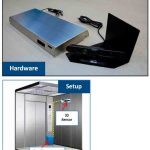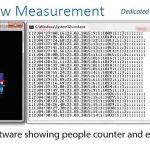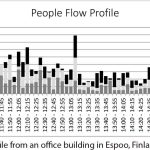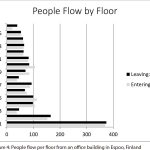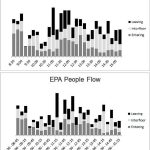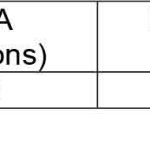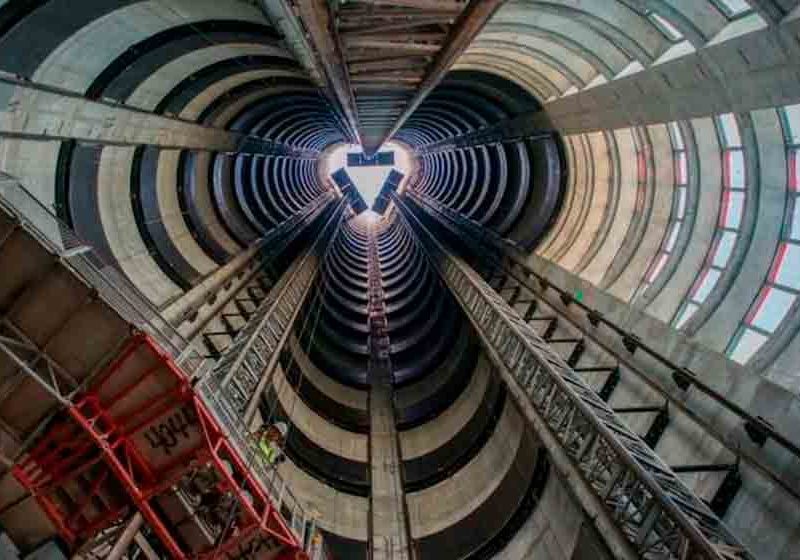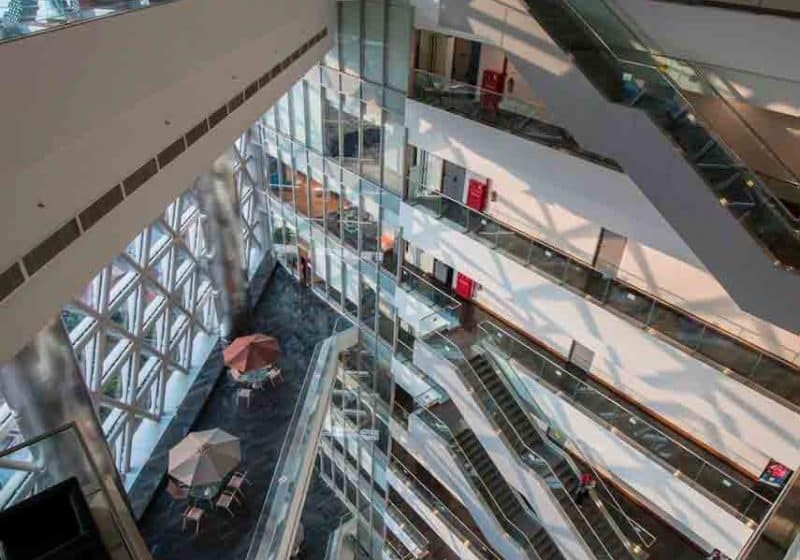Traffic Analysis for High Rise Buildings to Be Modernized
Jun 1, 2018

New KONE product improves analysis for projects during and after modernization.
by Darren Batey and Mikko Kontturi
This paper was presented at  Madrid 2016, the International Congress on Vertical Transportation Technologies, and first published in IAEE book Elevator Technology 21, edited by A. Lustig. It is a reprint with permission from the International Association of Elevator Engineers
Madrid 2016, the International Congress on Vertical Transportation Technologies, and first published in IAEE book Elevator Technology 21, edited by A. Lustig. It is a reprint with permission from the International Association of Elevator Engineers  (website: www.elevcon.com).
(website: www.elevcon.com).
In modernization, the measurement of existing traffic in a building is a difficult, time-consuming and costly affair, since old control systems often do not provide performance statistics. General traffic profiles with estimated population assumptions are, therefore, frequently used in traffic analysis. However, they do not provide sufficient accuracy. Using 3D camera technology, KONE has developed the Elevator Performance Analyzer (EPA) to accurately measure the people flow and elevator-system performance in an existing building. The results can then be used to estimate the performance improvements with a new product.
KONE EPA will improve analysis not only for completed modernization projects, but also of the effects during the modernization. This approach offers a unique and more accurate method than any current practice available in the market.
Introduction
The number of existing buildings requiring modernization is continuing to grow. Forecasts suggest that the global elevator stock will increase from 14,260,000 units in 2014 to 22,710,000 units in 2024, and, during this same period, the modernization and repair market will grow from US$34 billion to US$49 billion.[3] New high-rise buildings are often being constructed around existing buildings. Therefore, it becomes challenging for building owners to keep the property competitive to maintain existing tenants and/or attract new tenants. The typical reason for buildings requiring modernization is due to poor aspects of people flow caused by:
- Growth of building population compared to that originally planned, thus requiring more efficient use of the building
- Change of use of the building
- Overall reliability of elevators
Other reasons may include:
- Running costs (high energy consumption, need for frequent small upgrades and maintenance, etc.)
- Building image: new building(s) being built with the latest technological innovations
- Return on investment: normally, it is cheaper to modernize an existing building than demolish it and rebuild a new one.
Destination control systems (DCSes) have become the new norm for modernizing existing buildings. Some analysts and researchers are forecasting that up to 48% of all DCS/“smart elevator” deliveries in 2020 will be for the modernization of existing elevators.[2]
The challenge in making accurate traffic analysis is to acquire the correct input data to make the simulations that match what is happening in the building, then propose a people-flow solution that will minimize or eliminate any existing problems.
One of the key input data items for the simulation is the population in the building and the movement of people throughout the building.
The people-flow profile used in the analysis is also very important. Different building types have different profiles: e.g., residential buildings have a completely different profile than a single-tenant office building. Companies like KONE, which have extensive experience with elevator monitoring systems, have very good understanding of the typical people-flow profiles for different segments and can use that knowledge when making analyses.
The traffic analysis obtained using estimated populations and typical segment profile data may cause confusion between traffic experts and building owners or facility managers, as the analysis often does not match what is happening in the building.
The analysis can be done in two ways. For cases where the building is fully refurbished, the performance approach from the new building segment can be used. For cases where the building is kept fully occupied with existing tenants throughout and after the modernization period, more accurate information is needed to confirm the impact of the modernization.
With an accurate people-flow detection tool, it is possible to provide information about the current situation in an existing building and create a more comprehensive understanding for the whole modernization approach, from beginning to end. Understanding the building population, as well the population flow at peak periods accurately while working under the conditions of an occupied building, is important. It creates opportunities in advance to provide counter measurements for elevators to maintain an acceptable service level. Advanced planning can be used to define:
- How many elevators can be modernized simultaneously
- How to adjust the working hours for different tenants/departments to ease morning and lunch peaks
Accurate planning and communication toward building users can reduce unnecessary complaints from tenants.
Parameters Needed for Modeling
The traffic analysis or simulation is often the basis for the investment decisions for the modernization, as well as how to plan and carry out the modernization project. It gives answers to questions such as:
- At the end of the modernization, can I get rid of the morning crowd in the lobby?
- How can I reduce the time people need to wait for an elevator?
- What will happen to the people flow if one or two elevators are out of service due to the modernization work?
The “before modernization/during modernization/after modernization” analysis is very important and should be based on the real understanding of the building and its people flow. Therefore, when modeling an existing building, the most challenging aspects are defining the existing population and elevator usage, or the buildings’ traffic patterns. The different ways to estimate potential users in the building currently are:
- Facility manager/building owner input
- Population estimates based on floor area, as in new construction buildings
- Manual counting
- Access-control data from turnstiles
- Existing elevator monitoring systems
- Connecting external logging devices to the control system
Not all facility managers and building owners are necessarily aware of headcounts of tenants, as floors are rented based on area. While an area-based approach is valid for new construction (e.g., 12 m2 per person), using the same assumptions and traffic profiles for existing buildings can lead to inaccurate traffic analysis results when compared to the actual performance during or after modernization when the modernization is evaluated.
Manual counting can be conducted in multiple ways:
- Only at the main lobby
- In the elevator car
- Using closed-circuit television and elevator monitoring systems
Manual counting can provide more accurate information on people movements in the building, but taking measurements is time consuming and expensive, and, naturally, there is the possibility of human error. Not only is it costly, but combining available data into profiles that are usable in traffic analysis takes time and is usually missing the interfloor traffic angle, which is also applicable to the data provided through turnstile accesses.
Existing elevator monitoring systems or external data loggers can often provide statistics from previous usage of elevators. However, with conventional controls, which form the majority of today’s modernization projects, it is challenging to get any data other than the number of calls per floor. Without accurate statistics on population, this data cannot be used as a standalone source of information to provide accurate traffic profiles for analysis.
In real-world situations, there are multiple variables that affect human behavior and are not necessarily easily identified: for example, cases where the lobby layout has affected the usage of elevators and, thus, the results of traffic analysis. Depending on the case, using only theoretical values can be misleading if elevator usage cannot be fully understood. Without KONE EPA, heavy investments would be necessary to obtain reliable profiles for analyzing traffic in existing buildings with sufficient accuracy to provide the magnitude of improvement in terms of elevator performance.
In the future, with DCSes, where each passenger is assumed to give a call from landing to landing, more accurate information can be obtained through elevator monitoring systems, compared to today’s solutions. Even then, people-flow measurements are not without value, as the KONE EPA can be used to count the number of “ghost” passengers who did not give a call by themselves.
In addition to building population and traffic patterns, the performance of the existing elevators forms the basis of analysis for modernization, and the following parameters should be known:
- Door times
- Flight times
- Speed and acceleration
EPA
KONE, along with its technology partners, understands it is extremely difficult to obtain accurate information about actual elevator use of existing buildings from the building owner, facility managers or tenants. Therefore, different measurement methods have been investigated, and the KONE EPA was developed. The key criteria considered while developing the device were:
- To be independent of the elevator control system
- The device learns the building floors automatically.
- To be independent of the lift power supply
- Quick and easy to install
- Accuracy greater than 95%
- The privacy of elevator users must be respected.
The required specification and understanding for the input data necessary for making accurate traffic analysis of the people flow in a building determines the equipment needed.
An example of the type of question asked was, “Do we need to track a person through the building, or is it enough just knowing that a person has entered an elevator at a certain floor, and a passenger has left the elevator at another floor for accurate traffic analysis?”
The KONE EPA system is patented and consists of both hardware and software. The hardware is installed in the elevator cabin independent of any lift systems. It uses various sensors to count the number of users entering and leaving an elevator and the floors at which they enter and leave. The hardware is divided into two parts:
- A 3D sensor mounted to the elevator cabin side wall
- A data-recording box (which consists of a minicomputer, accelerometer, magnetometer and battery) mounted to the front wall of the elevator cabin
There are 3 subsystems in the device:
- Floor detection unit (FDU)
- Door detection unit (DDU)
- People counter
Each of these subsystems saves raw data to the minicomputer for later analysis. The FDU uses the magnetometer to map the served floors and their respective heights in a building. Every floor has a different magnetic fingerprint. The DDU uses 3D images to determine the door status, and door opening and closing times per floor.
The people counter uses 3D images converted into a plan view of the elevator entrance and counts the people entering and leaving the elevator.
An essential element of the system is the standalone analysis software. The software combines the various raw data files and the counting of people movement from the 3D sensor files into one event log. The analysis software converts the 3D sensor video into a two-dimensional plan view, in which users are not recognizable. The analysis software can detect direction using two virtual lines created at the door entrance. If an object moves through the red line and then through the green line, the object is entering the elevator. An object is identified as exiting if it first moves through the green and then the red line.
The KONE EPA Analysis software also generates many other reports than just people entering and leaving a floor. Other available reports include:
- Door opening times
- Door closing times
- Door open duration
- Accrued population in building shown in 5- and 15-min. increments
- Number of starts (in total per elevator and by floor)
- People flow profiles
- Floor-to-floor times
- Floor heights
- Acceleration and deceleration rates
- Round-trip times
- Elevator speed
The reports can be shown either for group or individual elevators, making it also possible to understand how individual lifts are being used and how elevator arrangements are affecting elevator usage.
The KONE EPA has been rigorously tested during the development period through:
- Comparing results with traditional manual counting
- Verifying that the people counter is counting correctly
The KONE EPA has major advantages over traditional manual counting:
- Accuracy of data: during busy periods, it can be difficult to count all passengers entering and leaving an elevator at a floor.
- Time: with manual counting, all the hand-recorded data needs to be consolidated into one data set to allow analysis.
- Cost: only one person is needed to set up equipment.
- Automatically generated reports
Device Accuracy
During the design phase of the KONE EPA, the target was set to a minimum 95% accuracy. This precision can be achieved with the current specification. KONE EPA can recognize both crowded situations and large groups accurately during normal usage.
The most challenging situation in detecting passengers with advanced computer programs and logic is when passengers are staying in the car entrance for extended periods and hold the door open for the next passengers or some other reason. Such situations affect the results when compared to manual counting but are not frequent when considering typical office buildings, and, in extreme cases, can be detected from long door times.
Occasionally, KONE EPA does miss passengers entering or leaving the car, but the test results suggest that the error level is less than 5%.
Manual counting was done by monitoring sensor data for each elevator in the group and a group of four elevators, which were measured at the same time, and counting the number of persons using elevators. In the studied data, there was one occurrence where a passenger held the door open by standing in the car entrance blocking the doors, which explains an additional two persons compared to manual counting.
When considering the accuracy of the traffic profile in terms of traffic by the three components (incoming/outgoing/interfloor), comparisons have been carried out in an office Building in Espoo, Finland, equipped with a DCS, by comparing KONE EPA results to the KONE Traffic Forecaster data (Figure 5). The profiles from EPA and Traffic Forecaster are close to each other. As these devices did not measure traffic at the same time, some passengers are registered at different timeframes, which causes variance in the results when comparing EPA and Traffic Forecaster. Profiles from EPA can be used for simulation of existing buildings, and, when compared to the current methods, this detailed data is hard to achieve.
Verification of the people moving into and out of the elevator was carried out by comparing the automatically counted values against the manually observed count.
Over several hours, the “object at the door area” was manually observed and compared against the associated automatic counter values (Figure 2) to determine the accuracy of detecting objects. The automatic-to-visual comparison gave a good understanding of the accuracy of the system, achieving better than the set 95% requirement.
Modernization Analysis Sequencing
Understanding how the existing population is moving around the building allows us to simulate how the existing elevators are performing and allows analysis of how the proposed changes will affect the operation of the elevators, including during the modernization period, when some lifts will not be available for use.
Traffic analysis for modernization requires many simulations to be completed:
- As is: the situation now, with existing population and elevator parameters
- How the elevators will perform after modernization with the existing population
- How the elevators will perform during modernization with some lifts not available for use: this may require more than one analysis, depending on how the upgrades are being scheduled and if an overlay is used to combine both new and old elevators under one group controller or not.
- How the elevators will perform after modernization using established industry norms for number of users in the building, based on available floor space
When all the different analyses have been completed, it is possible to suggest a modernization sequence for the building that will impact the end users the least. The sequence will be different for each building, depending on the people flow in the building and agreed contract period.
Summary
The KONE Elevator Performance Analyzer is a major innovation for measuring the traffic patterns in an existing building. The device allows a cost-effective, easy-to-use and accurate alternative to the existing methods of measuring building population and vertical movement in a building.
The information available from the KONE EPA reports allows accurate simulation of the existing situation. Being based on the real movement of people in a building, it permits study of the effects any proposed upgrades will have on the people flow in the building.
Acknowledgements
Your authors thank Dr. Marja-Liisa Siikonen and Risto Kontturi for their guidance and support during the writing and research of this article.
- Figure 1: The equipment and how it is set up in an elevator
- Figure 2: Analysis software showing people counter and event log being created
- Figure 3: Daily profile from an office building in Espoo, Finland
- Figure 4: People flow per floor from an office building in Espoo, Finland
- Figure 5: KONE Traffic Forecaster and EPA traffic profile
- Table 1: Persons using elevators — accuracy
References
[1] (News Article) “Smart Elevator Market Will Reach $23.16 Billion, Global, by 2020.” IoT Business News, December 2, 2014 (iotbusinessnews.com/2014/12/02/31626-smart-elevator-market-will-reach-23-16-billionusd-global-by-2020/smart-elevators).
[2] Industry Study #3324 World Elevators – October 2015 – Freedonia. www.kone.com
Get more of Elevator World. Sign up for our free e-newsletter.
